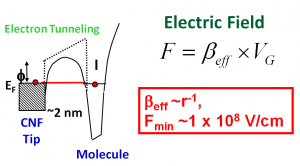Current Collaborators: A. I. Akinwande (EECS), D. Jeng (EECS), X. Wang (EECS)
Previous Collaborators: B. Adeoti (M.Eng EECS’08), L-Y. Chen (Ph.D. EECS’07)
Funding: DARPA/MTO, AFOSR

Similar to electron field emission, field ionization of gas molecules is produced by quantum tunneling of electrons through a potential barrier that is narrowed by the presence of a local high field (Fig. 1). However, field ionization is a quite different physical phenomenon. In field ionization, the electron flux goes from the neutral gas molecule to the field enhancer. Also, the height of the potential barrier is defined not only by the workfunction f of the field enhancer surface but also by the ionization potential I of the gas molecule. Field ionization requires substantially higher fields, typically of the order of 108 V/cm. Field ionization has two distinctive regimes of operation (Fig. 2):
- A high-field regime, where the ionization probability is so high that all molecules that enter the ionization volume surrounding the field enhancer are field ionized. The ion current will thus depend solely on the supply of neutral gas molecules to the ionization region. Therefore, in the high-filed regime the ion current II is approximately

where q is the electron’s charge, n is the number density of the gas (i.e., number of gas molecules per unit of volume), c is the thermal speed of the gas molecules, An is the surface area of the ionization region (i.e., volume at which the electric field is high enough to cause field ionization -a function of the bias voltage VG), and is the particle flux to the field enhancer due to polarization forces.
- A low-field regime that is characterized by a rate of ionization visibly smaller than the supply of neutral molecules to the ionization region. In this regime, a molecule that reaches the ionization region surrounding the field enhancer tip gets ionized with some probability D. The ion current in this regime is directly proportional by the equilibrium number of particles near the tip (the number density is set by the pressure and temperature of the gas, the ionization volume v is set by the bias voltage VG) and inversely proportional to the mean lifetime of the molecule with respect to the ionization process. In other words
where f is the barrier attempt frequency. The tunneling probability D is inversely proportional to the exponential of the electrostatic field, which is proportional to the field factor of the field enhancer.


